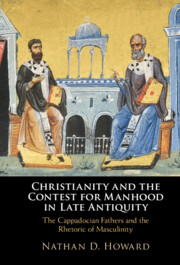 Christianity and the Contest for Manhood in Late Antiquity
Christianity and the Contest for Manhood in Late Antiquity Epistolary Agōn and Second Sophistic Origins
Published online by Cambridge University Press: 10 November 2022
Chapter 1 treats the epistolary discourse of the Cappadocians as a simulation of agōn (contest) and as a locus for conspicuous display of aretē (manly virtue). It demonstrates that the Cappadocians staged literary exchanges as athletic and military ventures, enabling them to moderate a discourse on masculinity and to publicize the manhood of themselves and their addressees. The chapter explores how this culture of epistolary exhibition was rooted in the androcentric culture of paideia (education for elite males) and predicated on an ethos of competitive display similar to Second Sophistic oratory. The Cappadocians framed letter writing among intellectuals as an exercise in extreme exertion, one that promoted moral excellence. Unlike portrayals of verbal duels among orators, where winners and losers resulted in a zero-sum outcome, in letter exchanges the Cappadocians promoted character formation for both author and recipient.In orchestrating these exercises in character formation, the Cappadocians cut across religious lines and established themselves as moderators of late-fourth century masculinity.
To save this book to your Kindle, first ensure no-reply@cambridge.org is added to your Approved Personal Document E-mail List under your Personal Document Settings on the Manage Your Content and Devices page of your Amazon account. Then enter the ‘name’ part of your Kindle email address below. Find out more about saving to your Kindle.
Note you can select to save to either the @free.kindle.com or @kindle.com variations. ‘@free.kindle.com’ emails are free but can only be saved to your device when it is connected to wi-fi. ‘@kindle.com’ emails can be delivered even when you are not connected to wi-fi, but note that service fees apply.
Find out more about the Kindle Personal Document Service.
To save content items to your account, please confirm that you agree to abide by our usage policies. If this is the first time you use this feature, you will be asked to authorise Cambridge Core to connect with your account. Find out more about saving content to Dropbox.
To save content items to your account, please confirm that you agree to abide by our usage policies. If this is the first time you use this feature, you will be asked to authorise Cambridge Core to connect with your account. Find out more about saving content to Google Drive.